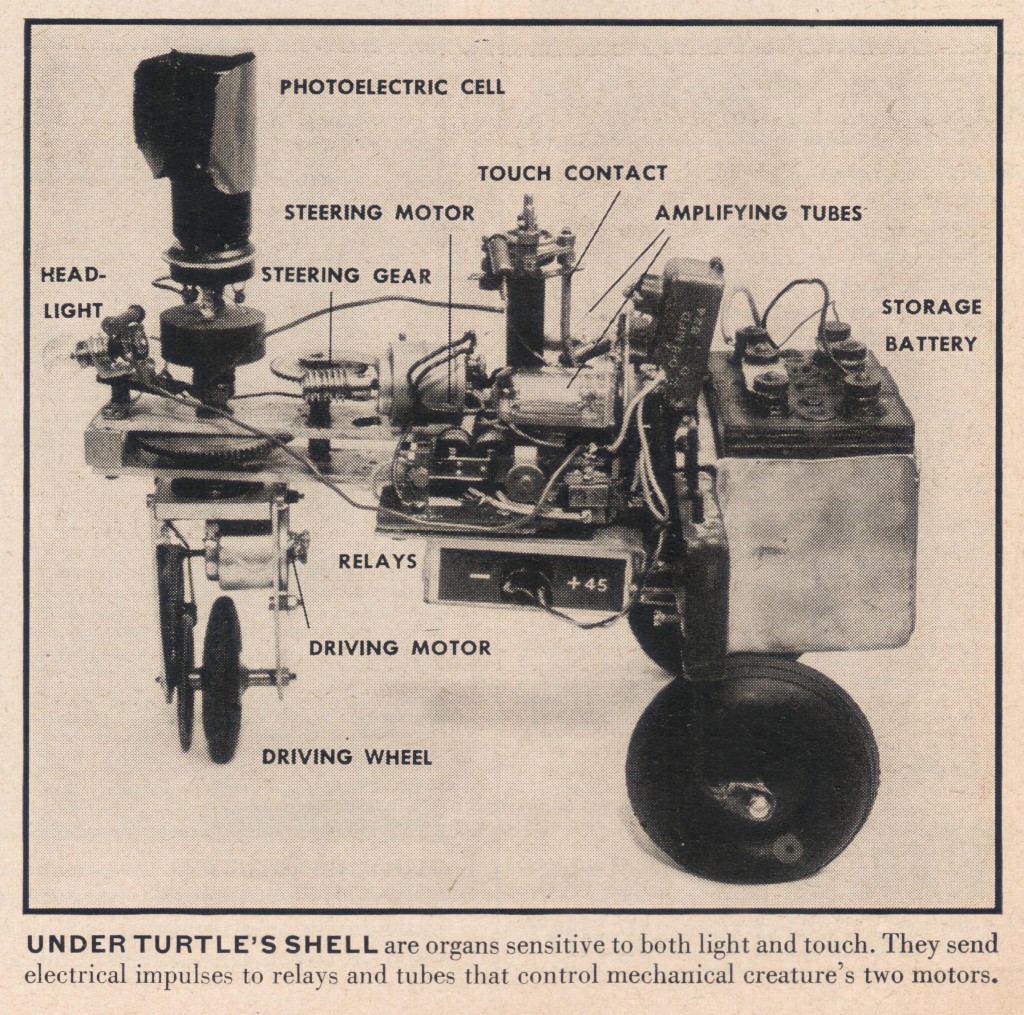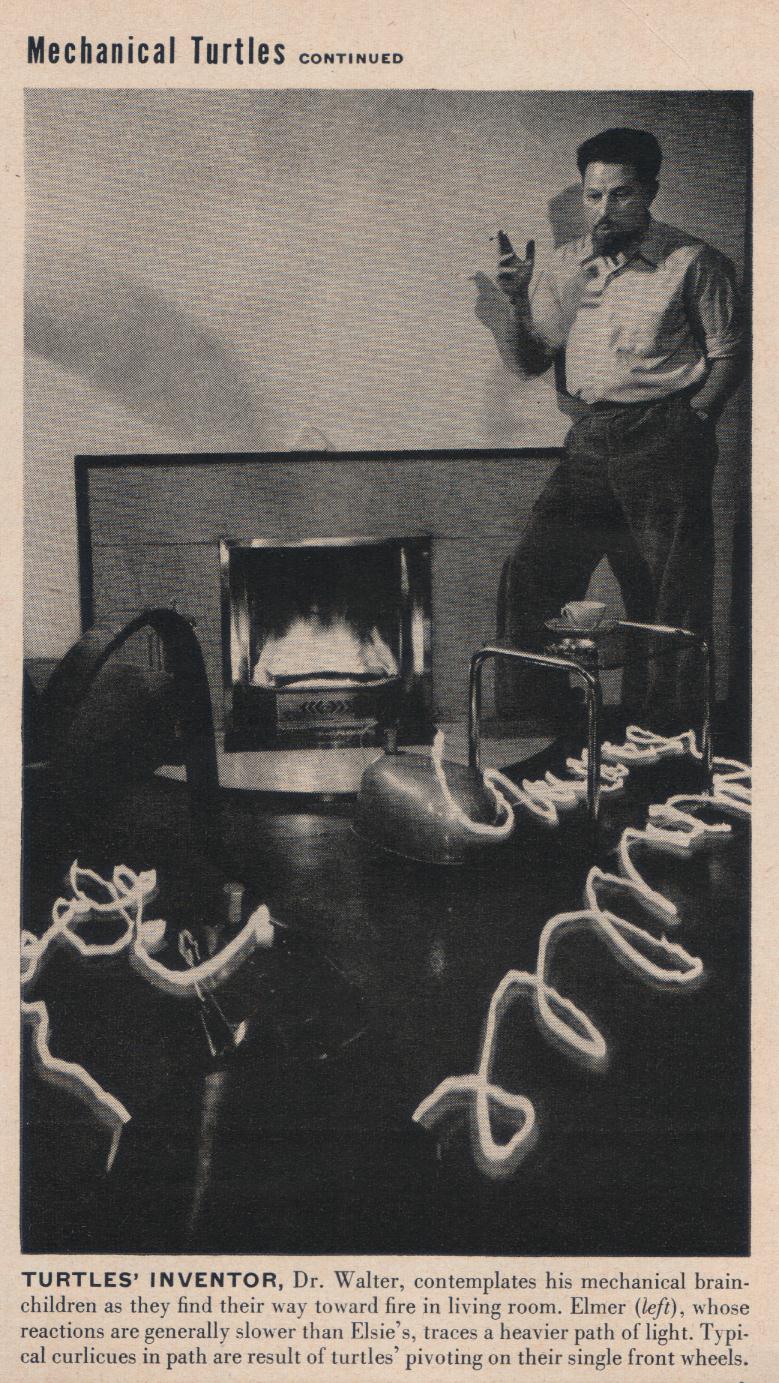



| operating states | ||
|---|---|---|
| original circuit description | simplified description | schip's GWT operation |
| SEARCH | ||
|
This is the normal operating condition of the circuit with Tube 1
biased ON and
Tube 2 biased OFF. As a result Relay K1 contacts connect half current
to the
Drive motor and Relay K2 contacts connects full current to the Turn
motor. The Steering motor continuously turns the vector of the front drive wheel and the photo cell. The result is a spiral motion of the turtle with the aperture of the photo cell scanning the horizon like a rotating radar dish. When the turtle returns from MOVE to SEARCH mode the Photocell turns away from the light source, the Tube 1 control grid voltage rises and turns Tube 1 further ON. The negative pulse on the Tube 1 anode coupled through C2 further turns Tube 2 OFF. The Photocell continues to turn past the light source. As it rotates fully, the same light source, now closer, comes into view again and the turtle returns to MOVE mode. |
When there is no signal from the Photocell, the Steering motor rotates at full speed while the Drive motor rotates at half speed resulting in slow small spiral movements of the turtle. If the Photocell detects a signal the robot goes into the MOVE mode. When the turtle returns from MOVE to SEARCH mode, the Photocell will have rotated away from the light. The turtle continues rotating until light is again detected. |
With no input signal the GWT runs it's Drive motor at a slow speed and
sweeps it's Steering motor 180║ back and forth over a period which allows
it to make a full circle. This scans the horizon as it were.
If a signal is detected the GWT goes to the MOVE mode. If a bumper is detected the GWT goes to the TOUCH mode. |
| MOVE | ||
| When the Photocell
is exposed to a moderate light
level it partially discharges C1 which lowers the Tube 1
grid voltage. This dip in grid voltage is amplified by Tube1 and
appears as a positive output
signal on Tube1 anode. Note also that the input signal is small and
Tube 1 anode current remains above the Relay
K1 drop out current.
This positive output signal is capacitively coupled through C2 to the grid of Tube 2. If this signal exceeds the turn-on threshold of Tube2, it is further amplified and energizes Relay K2 coil. Relay K2 contacts change state and the Steering motor stops while the Drive motor is connected to full current. With the photocell rotation stopped pointing to the light, the turtle now moves in a straight line in the direction of the light source. This MOVE motion continues for the duration of the R4/C2 time constant until the voltage at the Tube 2 grid drops the anode current below the Relay K2 holding current. Relay K2 contacts reconnect the Steering motor to full current and the Drive motor to half current. |
When the Photocell detects a signal, the turtle goes from SEARCH to MOVE mode. The Steering motor is stopped and the Drive motor rotates at full speed. This causes a motion straight towards the light. When [(I think...) the Photocell no longer detects a signal AND] a short timeout period has elapsed, the turtle returns to SEARCH mode. |
With a signal detected the GWT runs it's Drive motor at full speed
and tracks the signal by alternating the direction of the Steering
motor to maximize the signal. It moves towards the signal.
If the signal exceeds a pre-determined level the GWT goes to the DAZZLE mode. If a bumper is detected the GWT goes to the TOUCH mode. |
| DAZZLE | ||
| This occurs when
the light level on the photocell is high enough to deeply discharge C1.
Then Tube 2 anode current drops below the Relay K1 holding current and
Relay K1 contacts open to connect half
current to the Steering motor. At the same time the positive transition
on the Tube 1 anode turns on Tube 2
which causes Relay K2 contacts to connect the full current to the drive
motor. This is the first part of the DAZZLE mode in which the Drive
motor rotates full speed and the Steering motor rotates half speed
which causes the turtle to veer away from the light. The turtle moves
rapidly away from the light in a slow curve.
|
When the Photocell detects a strong signal the turtle enters DAZZLE mode. The Steering motor rotates at half speed and Drive motor at full speed. The turtle moves rapidly away from the light in a slow curve. As the Photocell is slowly turned away from the light it's signal drops and the turtle enters BLIND-SEARCH mode. |
With a strong signal detected the GWT runs it's Drive motor at full
speed and turns the Steering motor fully to the opposite direction
of its last travel.
This lasts for a period allowing a rotation of between 45-90║. At the end this period the GWT goes to BLIND-SEARCH mode. If a bumper is detected the GWT goes to the TOUCH mode. |
| BLIND-SEARCH | ||
|
This is the second phase of the DAZZLE mode, which occurs when the
photo cell turns away from
the light and C1 charges up again. When the Tube1 grid voltage rises it
turns Tube 1 ON and Relay K1 changes state. Importantly, the large
negative transition on Tube 1 anode, coupled through C2, turns Tube
2 OFF which drops out Relay K2. This large
negative signal drives Tube 2 deep into cutoff and ensures that during
the following few seconds Tube2 will not respond to small positive
pulses on the Tube1 anode resulting from periodic illumination of the
spinning photocell.
This is the same relay logic and motor operation as the SEARCH mode (Steering motor rotates at full speed and the Drive motor at half speed) but photocell signals are ignored until Tube 2 returns from cutoff. |
When the Photocell signal drops from a high value the turtle goes from DAZZLE to BLIND-SEARCH mode. This persists for several seconds, during which time the Photocell signal is ignored. As in SEARCH mode with the Photocell signal blocked, the Steering motor rotates at full speed and the Drive motor at half speed, resulting in slow small spiral movements of the turtle. When the Photocell-ignore timeout elapses the turtle returns to SEARCH mode. The net result of DAZZLE and BLIND-SEARCH is a fast large spiral away from the light source followed by a period of random small spirals until the normal phototropic SEARCH/MOVE behavior can resume. |
Tracking input signals are inhibited for a period of a few seconds
while the GWT runs it's Drive motor at a slow speed and sweeps it's
Steering motor 180║ back and forth.
At the end of the inhibit period the GWT returns to SEARCH mode. If a bumper is detected the GWT goes to the TOUCH mode. |
| TOUCH | ||
| The TOUCH mode occurs when the collision contact closes, which connects Tube2 output to Tube1 input through C3, R7 and R8 forming a cross coupled oscillator. The two inverters are connected in a loop through differentiating R/C networks and this positive feedback causing the circuit to oscillate between SEARCH and DAZZLE modes. The duty cycle of oscillation is 1/3 but is affected by the light level. (In BEAM robotics this network connection would be called a two Nv neuron grounded bicore). | When the bumper contacts are closed the turtle alternates between SEARCH and DAZZLE modes with a duty cycle of about 1/3. The period of this depends on the Photocell signal, such that oscillations in the dark take longer than in light. This alternates Steering and Drive motors rotating at full and half speed resulting in slow small spiral movements of the turtle interspersed with fast open curves. And (hopefully) it moves away from the obstruction. |
When a bumper is detected the GWT runs it's Drive motor in reverse
at a slow speed and turns it's Steering motor towards the bumper switch
that was activated. If both bumpers are activated the GWT turns to the
opposite direction of its last travel. This backs up and turns
away from the offending bumper.
TOUCH mode lasts for a period to allow a rotation of about 90║, at which time the GWT returns to SEARCH mode. |
| LOW-BATTERY | ||
| The LOW BATTERY
MODE can occur when circuit bias
conditions are chosen so that a low motor battery
voltage will result in the MOVE mode without the DAZZLE termination and
hopefully results in the turtle
entering its brightly lit hutch for a battery charge.
The battery charger interface cleverly uses two additional relays to disconnect the motor battery from the rest of the circuit to protect the battery from over discharge, to turn of the motors and the rest of the circuit during charging and to reconnect the battery to the circuit when fully charged. As long as the charging current is high enough, the K4 contact remains open and charging continues. When the battery is fully charged, the charging current tapers off and K4 drops out. This reconnects the positive 6V battery terminal to the main circuit which powers up M. speculatrix to drive forward and immediately enters the Touch mode to extracts itself from the charging dock and resume normal mode operation. |
When the battery is low DAZZLE mode is disabled and the turtle continues to MOVE towards the light. If the light is at a charging station this will (maybe) cause it to connect and recharge. While charging the drive system is disabled. When the battery is fully charged the normal SEARCH/MOVE behavior is re-enabled and the turtle moves away from the charging station's bright light. |
When the battery is low the GWT will turn it's Steering motor fully
to 180║ and run it's Drive motor at slow speed alternating directions
as a signal that it needs juice.
Input signals and bumper switches are ignored. |
| CAPTURED-DAZZLE | ||
| If there is a possibility that the photocell is continuously exposed to bright light no matter what direction, the turtle can hang up with the steering motor ON and the drive motor OFF. | I'm not sure how this happens??? Or what it means... |
If there is no signal change detected, either consistently too low or too high, the GWT remains in SEARCH mode. |